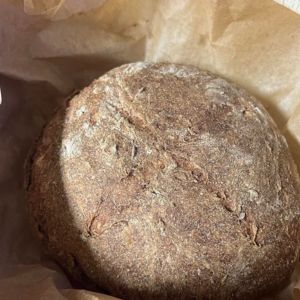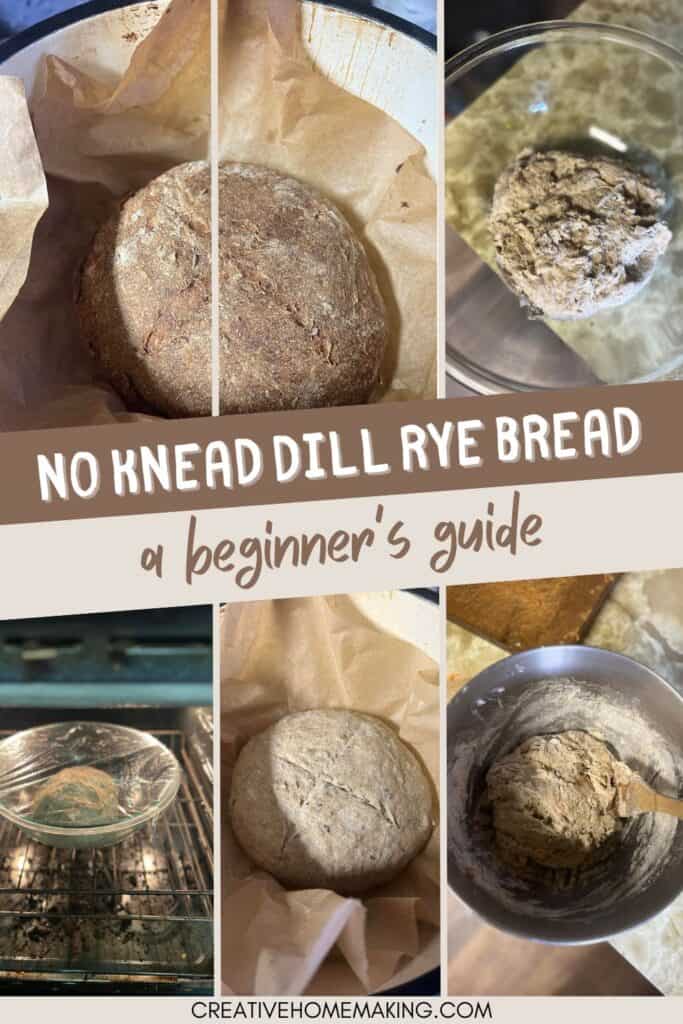No knead dill rye bread is a delicious and easy-to-make bread that requires no kneading. It is perfect for those who love the taste of rye bread but don’t want to spend hours kneading and waiting for the dough to rise. This bread has a unique flavor that comes from the combination of rye flour and dill, making it a perfect addition to any sandwich or as a side dish to a hearty soup.
This post may contain affiliate links.
One of the best things about no knead dill rye bread is that it requires very little effort to make. All you need is a few simple ingredients and a little bit of time. The recipe usually involves mixing the ingredients together, letting the dough rise, and then baking it in the oven. The result is a flavorful and hearty bread that is perfect for any meal.
Related Article: The Best Way to Freeze Bread
Overall, no knead dill rye bread is a great option for those who want to make homemade bread without the hassle of kneading. With its unique flavor and easy-to-follow recipe, it is sure to become a staple in any kitchen.
Related Article: Quick Sourdough Pizza Dough: A Delicious and Easy Recipe
Understanding No Knead Dill Rye Bread
No knead dill rye bread is a delicious homemade bread recipe that is easy to make and full of flavor. This bread is made with a combination of rye flour, bread flour, warm water, and a splash of olive oil or dill pickle juice. The addition of everything bagel seasoning and caraway seeds gives this bread an extra kick of flavor.
No knead bread is a type of bread that is made without kneading the dough. Instead, the dough is mixed together and left to rise for an extended period of time. This process allows the gluten to develop on its own, resulting in a bread that is light and airy with a crisp crust.
Rye bread is a type of bread that is made with rye flour. Rye flour has less gluten than wheat flour, which makes it more difficult to work with. However, the addition of bread flour to this recipe helps to balance the gluten levels and create a bread with a great texture.
Related Article: Pull Apart Garlic Bread
Making no knead dill rye bread is a great way to experiment with different flavors and textures in homemade bread. The addition of dill and everything bagel seasoning gives this bread a unique flavor that is perfect for sandwiches or as a side dish to soups and stews.
Overall, no knead dill rye bread is a delicious and easy bread recipe that is perfect for both beginners and experienced bakers. With a little bit of patience and some simple ingredients, anyone can make a delicious loaf of homemade bread.
List of Ingredients
When it comes to making no-knead dill rye bread, there are a few essential ingredients that you will need to have on hand. Additionally, there are some optional add-ons that can help enhance the flavor and texture of the bread. Here is a breakdown of the ingredients you will need:
Essential Ingredients
- Flour: For this recipe, you will need a combination of bread flour and rye flour. Bread flour is used for its high gluten content, which helps give the bread structure and chewiness. Rye flour, on the other hand, adds a distinct flavor and texture to the bread.
- Salt: Salt is a crucial ingredient in bread-making, as it helps to enhance the flavor of the bread and regulate the fermentation process.
- Dill Seeds: Dill seeds are an essential ingredient in dill rye bread, as they add a distinct flavor and aroma to the bread.
- Water: Water is used to hydrate the dough and activate the yeast.
- Dry Yeast: Dry yeast is used to help the bread rise. Make sure to use the correct amount of yeast specified in the recipe, as too much or too little can affect the texture and flavor of the bread.
Related Article: Traditional Irish Soda Bread Recipe
Optional Add-ons
- Butter: Adding butter to the dough can help make the bread softer and more flavorful.
- Caraway Seeds: Caraway seeds are often used in rye bread recipes, as they add a unique flavor and texture to the bread.
- Molasses: Molasses can be used to add sweetness and color to the bread.
- Sugar: Sugar can also be used to add sweetness to the bread.
- Olive Oil: Olive oil can be added to the dough to make it softer and more flavorful.
- Whole Wheat Flour: Adding whole wheat flour to the dough can help make the bread healthier and more nutritious.
Required Kitchen Tools
Making no knead dill rye bread requires a few kitchen tools to ensure a successful outcome. Here are the essential tools that one should have in their kitchen before starting:
Related Article: Sourdough Starter for Beginners: A Guide to Making Your Own Yeast
Bowl
A bowl is an essential kitchen tool for mixing the ingredients. A large bowl is recommended for making no knead dill rye bread, as it allows for enough space to mix the ingredients without spilling over.
Pot
A pot is needed to bake the bread. A Dutch oven is the best option as it allows the bread to bake evenly and retain moisture. A 5-6 quart pot is recommended for making no knead dill rye bread.
Related Article: One Hour Dinner Rolls
Whisk
A whisk is needed to combine the ingredients. A standard whisk is sufficient for mixing the dry ingredients, while a hand blender can be used for mixing the wet ingredients.
Scraper
A scraper is useful for removing the dough from the bowl and transferring it to the pot for baking. A bench scraper is recommended for this task.
Knife
A knife is needed to chop the dill. A sharp knife is recommended for this task.
Related Article: Easy Sourdough Bread Dutch Oven Recipe
Stand Mixer
A stand mixer is not necessary for making no knead dill rye bread, as the dough can be mixed by hand. However, a stand mixer can be used to mix the dough if desired.
Le Creuset
A Le Creuset is a type of Dutch oven that is made of cast iron and coated with enamel. It is a popular choice for baking bread, including no knead dill rye bread. However, any Dutch oven will work for this recipe.
Preparation Steps
No Knead Dill Rye Bread
Ingredients
- 1 cup whole wheat flour
- 1 cup all-purpose flour
- 1 cup rye bread
- 1 tablespoon caraway seeds (optional)
- 1 tsp. dry active yeast*
- 1 1/8 tsp. salt
Preparing the Dough
To make no-knead dill rye bread, start by combining all of the dry ingredients in a large mixing bowl. This includes rye flour, all-purpose flour, salt, yeast, and dill seeds. Mix them together until they are evenly distributed.
Related Article: No Knead Dinner Rolls
Next, add 1 1/2 cups hot water. Use a wooden spoon or your hands to mix everything together until a sticky dough forms.
Once the dough is mixed, cover the bowl with plastic wrap and let it rest on the counter for at least 3 hours. This will allow the dough to rise and develop flavor.
Rising and Folding
After the dough has risen, it’s time to fold it. Sprinkle a little flour on the counter and turn the dough out onto it. Use your hands to shape the dough into a ball, then fold it in half and in half again. Place the dough back in a bowl lined with parchment paper and cover it with a clean towel. Let the dough rise again for about 30 minutes.
Baking the Bread
While the bread is raising the second time, preheat your oven to 450°F. Put a Dutch oven with a lid in the oven to heat up.
Once the oven is hot, carefully remove the Dutch oven and take off the lid. Carefully remove the parchment paper with the bread dough from the bowl and set into dutch oven. Make a few slashes in the top of the dough to allow it to expand while baking.
Put the lid back on the Dutch oven and bake the bread for 30 minutes. After 30 minutes, remove the lid and continue baking for another 10 minutes, until the bread is golden brown and sounds hollow when tapped on the bottom.
Related Article: Homemade Hawaiian Sweet Rolls
Let the bread cool on a wire rack for at least 30 minutes before slicing and serving. Enjoy!
Post-Baking Instructions
Once the dill rye bread has finished baking, it is important to follow a few simple steps to ensure that it cools down properly and is ready to be served.
First, remove the bread from the oven and place it on a wire rack to cool. This will allow air to circulate around the bread and prevent it from becoming soggy on the bottom.
Next, cover the bread with a clean towel or plastic wrap to prevent it from drying out. Be sure to let the bread cool completely before slicing it. This will prevent the bread from becoming squished or misshapen during slicing.
Once the bread has cooled, use a sharp serrated knife to slice it. This will ensure that the bread slices cleanly and doesn’t become squished or torn.
If you’re not planning on serving the bread right away, store it in a bread bag or airtight container at room temperature for up to 3 days. For longer storage, wrap the bread tightly in plastic wrap and store it in the freezer for up to 3 months.
Serving Suggestions
Once the dill rye bread has cooled down, it’s time to enjoy it with your favorite toppings. Here are some serving suggestions to get you started:
- Sliced and Toasted: For a simple and classic way to enjoy the bread, slice it and toast it in a toaster or under the broiler. Spread some butter or cream cheese on top for a delicious breakfast or snack.
- Open-Faced Sandwich: Cut a slice of bread in half and top it with your favorite sandwich ingredients. Try smoked salmon, cream cheese, and cucumber for a refreshing and light option.
- Grilled Cheese: Make a classic grilled cheese sandwich with slices of dill rye bread and your favorite cheese. Add some sliced tomato or ham for extra flavor.
- Bread Pudding: Don’t let any leftover bread go to waste! Turn it into a delicious bread pudding by soaking the bread in a mixture of eggs, milk, and sugar. Bake it in the oven until golden brown and serve it warm with a dollop of whipped cream.
No matter how you choose to enjoy it, the dill rye bread is sure to be a hit with its hearty texture and savory flavor.
Frequently Asked Questions
What is rye bread made of?
Rye bread is made from a combination of rye flour and wheat flour. The ratio of rye flour to wheat flour can vary depending on the recipe. Some rye bread recipes also include additional ingredients such as caraway seeds, molasses, or honey.
Can I make no-knead rye bread in a loaf pan?
Yes, you can make no-knead rye bread in a loaf pan. Simply shape the dough into a loaf and place it in a greased loaf pan. Let it rise and bake according to the recipe instructions.
Is no-knead bread better than kneaded bread?
There is no definitive answer to this question. Some people prefer the texture and flavor of no-knead bread, while others prefer the texture and flavor of kneaded bread. No-knead bread is generally easier to make and requires less hands-on time, but kneaded bread can be more satisfying to make and shape.
Follow my homemade bread recipes board on Pinterest.






